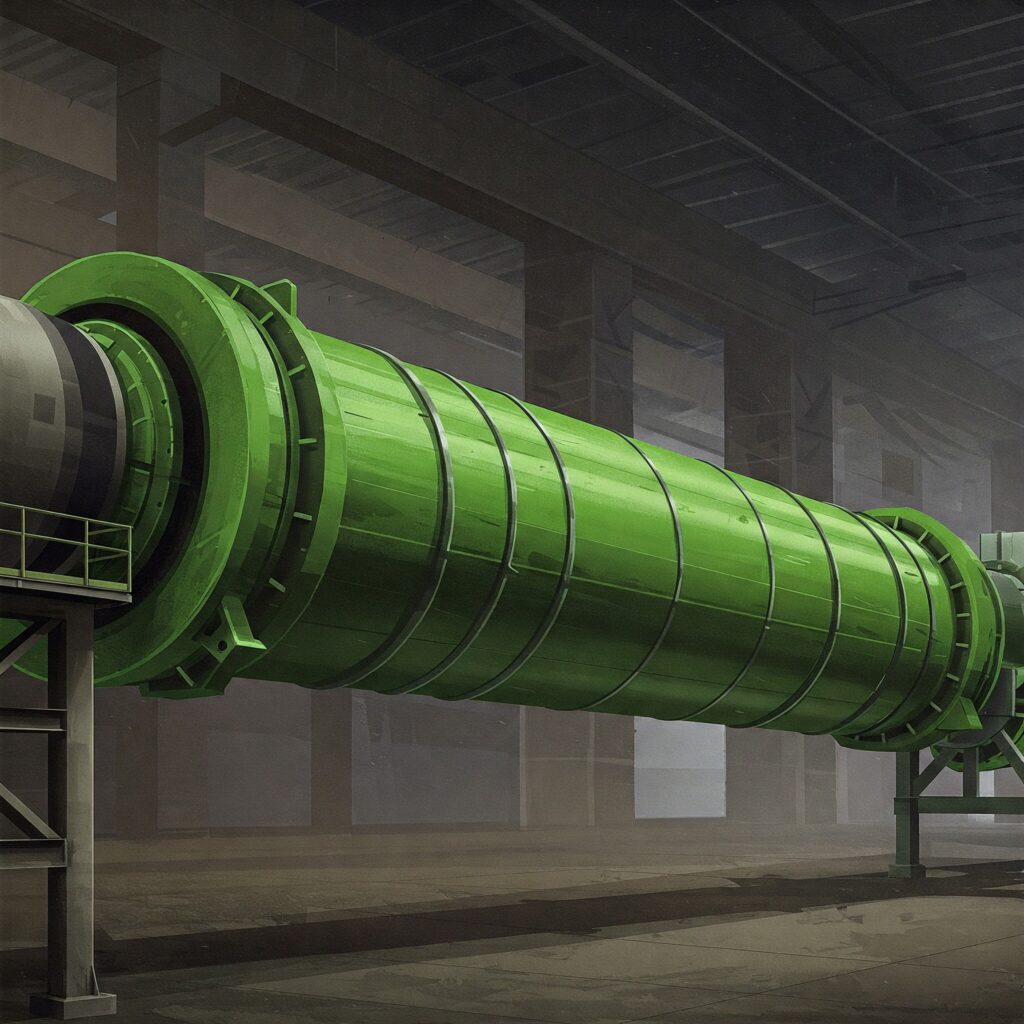
Image credit: Google Gemini
TL&DR summary: hydrogen can be used in cement production as a natural gas replacement, but that doesn’t solve the entire CO2 emissions of cement production. There are other problems like the lack of hydrogen flame radiance, but the deal killer is the cost per tonne of CO2 emissions averted. Hydrogen may have a role, but that role is not certain to be a major one.
Cement is the glue that reacts with water to hold concrete together. Portland cement is made from a mixture of limestone (CaCO3), clay/shale (a complex mixture of silica-alumina minerals) and iron oxides. The process has two distinct steps: calcining, where CO2 is driven off limestone (CaCO3) by heating it to form lime (CaO), and “clinkering”, where the complex mixture of calcium alumino-silicates is formed into lumps by partial melting at very high temperatures (1450 C).
About 60% of the CO2 generated by cement manufacture is the fossil CO2- quite literally fossil in this instance- liberated by calcining of limestone, which formerly was the shells of ancient sea life. The balance, about 40%, is from fossil fuels used to provide the necessary high temperature heat.
As cement cures in a concrete mixture, over a period of about 100 years, some of the silicates in the cement “weather”, reacting with atmospheric CO2 to form carbonates again. This process recovers about 15-17% of the cement-making process.
https://www.sciencedirect.com/science/article/abs/pii/S0195925514000055
Overall, cement making is a massive fossil CO2 emitter, representing about 8% of world CO2 emissions.
Cement is a low cost commodity material which requires production at scale to be economic, and which also requires proximity to feedstocks and to markets to provide affordable logistics. Only 1-2% of cement today is imported/exported- almost all cement production is local to the country where it is used.
Options for Emissions Reductions From Cement Use
Cement is over-used, because it is cheap. Alternatives do exist, such as using more wood and other cellulosic materials in above-grade construction, the use of steel screw piles in place of concrete foundations etc. But to be clear, concrete is extremely useful, particularly in the subsurface and in direct weathering applications. We have little alternative but to find better ways to make and use cement.
Approaches other than substitution, fall into several categories:
Strength Enhancement/Cement Reduction
Certain concrete additives, alternative pozzolanic materials (things that substitute for cement), and special curing conditions (for products like precast concrete and concrete masonry units) can allow us to achieve the same strength while using less Portland cement. However, one alternative pozzolanic material is fly ash from coal combustion, which also must end in a decarbonized future.
Alternatives to Limestone
Companies like Brimstone are developing processes by which the complex mixture of calcium silicates that make up Portland cement, can be made from silicate rather than carbonate minerals, potentially eliminating that ~40% of CO2 emissions associated with calcining. However, these processes have a long technology development road ahead. Furthermore, such processes may still require high temperature processing steps akin to “clinkering”, so the emissions from the fuels use thereof are a separate problem that still needs to be solved.
Carbon Capture and Storage
The CO2 emissions from cement production, particularly from calcining, are comparatively easily captured because the concentration of CO2 is higher in the flue gas stream than is found in a typical fossil fuel combustion system. However, the fundamental problem with CCS is cost per tonne of CO2 for both capture and durable storage in the subsurface. Furthermore, cement production tends to be centred around serving a local concrete consumption industry with the logistics of both raw materials supply and product distribution being important to the economics of the business. Subsurface reservoirs suitable for CCS are not guaranteed to be anywhere near the sites of cement production, and distribution of CO2 to distant burial sites adds considerable cost and risk.
Electrification of Calcining
Calcining is well within the temperature limits of electric heating, allowing a considerable reduction in the fuel-related emissions from cement production. Electric calcining provides the additional benefit of a nearly pure CO2/steam stream which would make CO2 capture trivially easy- though not without cost, as compression and dehydration are required even for pure CO2. The problem of the “S” part of the equation described above, obviously remains.
Clinkering is the Real Problem
While some development of plasma arc-based clinkering is underway, it is clear that the temperatures required inside a clinkering kiln are not easily electrified.
Clinkering is accomplished in rotary kilns, which are large rotating inclined steel tubes lined internally with refractory bricks. The bricks serve as insulation against the high temperatures, allowing the steel to be cool enough that it retains the necessary strength. Feed materials enter at one end, and a large radiant jet flame is emitted by fuel burners at the other end. The radiation from the flame, and to a limited extent, convection from the hot flue gases, heat the bricks and the solid feed material. As the kiln rotates, solid material advances along the tube, comes in contact with heated bricks, and gradually forms balls of semi-melted material which exit as finished “clinker”.
Note that it’s not mere high temperature heat that’s required here, but intense infrared radiation. And that radiation must be emitted inside the brick-lined kiln.
Coal is the perfect material for clinkering kiln firing because a powdered coal flame emits extremely strong radiation. Natural gas can be substituted, but is less preferred despite its lower GHG emissions due to reduced flame radiance. Various strategies have been used to enhance the flame radiance and reduce fuel cost or generate additional sources of revenue. Oxygen addition to enhance flame temperature in natural gas fired kilns is one option. Another, used in both coal and gas fired kilns, is the addition of waste materials, including tires, hazardous liquid organic wastes, agricultural wastes and liquid sewage, and refuse-derived fuel (RDF), such that the cement kiln doubles duty as a waste incinerator.
Electricity Can’t Do it- Therefore Hydrogen?
Hydrogen certainly can be used as a fuel in cement clinkering kilns. However, the list of problems is considerable.
Hydrogen flames are even less radiant than natural gas flames, requiring the addition of even more waste or alternative fuels to increase radiance. Adding char or cellulosic biomass (wood flour) is one option that is fairly low in GHG emissions. But any refuse derived fuel will have a net calorific value that is largely fossil in origin, i.e. coming largely from plastics and synthetic materials made from fossil materials. The use of such fuels therefore increases fossil CO2 intensity, reducing the GHG emission benefits of using hydrogen.
Hydrogen’s cost per joule is very high relative to other fuels. Whereas wholesale natural gas in the US might be $3.50/MMBTU, (1 MMBTU = roughly 1 GJ), even “black” hydrogen made from natural gas without CO2 capture at a wholesale cost of $1.50/kg is $11/MMBTU- obviously considerably more expensive than the fuel it replaces. Green hydrogen is considerably more expensive than black hydrogen, with current production costs in the $6-$9/kg range. And even at future dreamland costs of green hydrogen of $3/kg, even assuming zero CO2e emissions from green hydrogen production (an ideal not achievable in practice) the displacement of natural gas with such hydrogen has a cost of about $350/tonne CO2 emissions averted. Green hydrogen is a very expensive decarbonization strategy when it is used as a fuel- even when used for very high temperature heating applications where direct electrification seem impractical.
Clinkering is a continuous process, and the equipment must be kept hot to avoid damage from thermal cycling. Operating periods of 18 months between shutdowns is not uncommon. Hence, any green hydrogen production used, must have considerable storage to ensure continuous supply. Intermittent operation of cement clinkering kilns will never be a technically feasible option.
Conclusions- How Do We Decarbonize Cement Production?
This is one of the most difficult problems for us to solve on our journey to decarbonization. A combination of many strategies will be required:
- Reduction of concrete use by substituting materials with better LCA performance
- Reduction of cement use by making better concrete
- Electric calcining, hopefully with carbon capture and storage- if we can afford it
- Alternative pozzolanic materials (under development)
- Using silicate instead of carbonate minerals (under development)
- Substitution of coal and natural gas with biomass/biochar and biogas methane as cement kiln fuels
- Electric clinkering via plasma arcs, if this can be commercialized
- Hydrogen as a partial fuel- but only in places in the world where high capacity factor green electricity is available greatly in surplus to local electrical needs
One thing is certain: cement and the concrete made from it, is a truly “hard to (totally) decarbonize sector”. Cement is going to be a lot more expensive in a decarbonized future, regardless how we do it- especially so if hydrogen is our only way out. And that begs the question: is cement the appropriate focus for near-term investments in decarbonization? Research and development- certainly. But in my view, we shouldn’t allow excessive worry about how to decarbonize the last 5-10% of GHG emissions, divert our attention from how to eliminate the easy 90-95%.
Disclaimer: this article has been written by a human, who is familiar with the issues involved but by no means a specialist in cement production. If I’ve made an error in my text, please provide the correction with references and I’ll be happy to edit the article to better reflect reality.
If, however, I’ve taken a dump on your pet commercial idea, please contact my employer, Spitfire Research Inc., who will be happy to tell you to piss off and write your own article.
